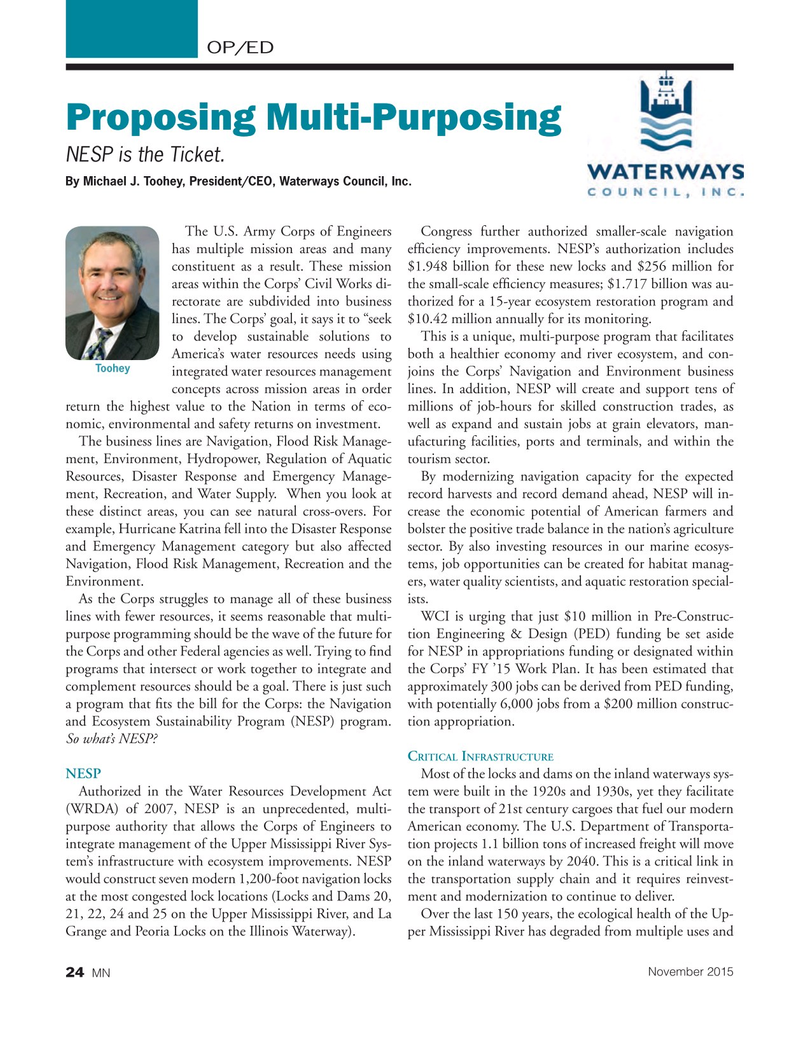
Page 24: of Marine News Magazine (November 2015)
Workboat Annual
Read this page in Pdf, Flash or Html5 edition of November 2015 Marine News Magazine
OP/ED
Proposing Multi-Purposing
NESP is the Ticket.
By Michael J. Toohey, President/CEO, Waterways Council, Inc.
The U.S. Army Corps of Engineers Congress further authorized smaller-scale navigation has multiple mission areas and many ef? ciency improvements. NESP’s authorization includes constituent as a result. These mission $1.948 billion for these new locks and $256 million for areas within the Corps’ Civil Works di- the small-scale ef? ciency measures; $1.717 billion was au- rectorate are subdivided into business thorized for a 15-year ecosystem restoration program and lines. The Corps’ goal, it says it to “seek $10.42 million annually for its monitoring. to develop sustainable solutions to This is a unique, multi-purpose program that facilitates
America’s water resources needs using both a healthier economy and river ecosystem, and con-
Toohey integrated water resources management joins the Corps’ Navigation and Environment business concepts across mission areas in order lines. In addition, NESP will create and support tens of return the highest value to the Nation in terms of eco- millions of job-hours for skilled construction trades, as nomic, environmental and safety returns on investment. well as expand and sustain jobs at grain elevators, man-
The business lines are Navigation, Flood Risk Manage- ufacturing facilities, ports and terminals, and within the ment, Environment, Hydropower, Regulation of Aquatic tourism sector.
Resources, Disaster Response and Emergency Manage- By modernizing navigation capacity for the expected ment, Recreation, and Water Supply. When you look at record harvests and record demand ahead, NESP will in- these distinct areas, you can see natural cross-overs. For crease the economic potential of American farmers and example, Hurricane Katrina fell into the Disaster Response bolster the positive trade balance in the nation’s agriculture and Emergency Management category but also affected sector. By also investing resources in our marine ecosys-
Navigation, Flood Risk Management, Recreation and the tems, job opportunities can be created for habitat manag-
Environment. ers, water quality scientists, and aquatic restoration special-
As the Corps struggles to manage all of these business ists. lines with fewer resources, it seems reasonable that multi- WCI is urging that just $10 million in Pre-Construc- purpose programming should be the wave of the future for tion Engineering & Design (PED) funding be set aside the Corps and other Federal agencies as well. Trying to ? nd for NESP in appropriations funding or designated within programs that intersect or work together to integrate and the Corps’ FY ’15 Work Plan. It has been estimated that complement resources should be a goal. There is just such approximately 300 jobs can be derived from PED funding, a program that ? ts the bill for the Corps: the Navigation with potentially 6,000 jobs from a $200 million construc- and Ecosystem Sustainability Program (NESP) program. tion appropriation.
So what’s NESP?
C I
RITICAL NFRASTRUCTURE
NESP Most of the locks and dams on the inland waterways sys-
Authorized in the Water Resources Development Act tem were built in the 1920s and 1930s, yet they facilitate (WRDA) of 2007, NESP is an unprecedented, multi- the transport of 21st century cargoes that fuel our modern purpose authority that allows the Corps of Engineers to American economy. The U.S. Department of Transporta- integrate management of the Upper Mississippi River Sys- tion projects 1.1 billion tons of increased freight will move tem’s infrastructure with ecosystem improvements. NESP on the inland waterways by 2040. This is a critical link in would construct seven modern 1,200-foot navigation locks the transportation supply chain and it requires reinvest- at the most congested lock locations (Locks and Dams 20, ment and modernization to continue to deliver. 21, 22, 24 and 25 on the Upper Mississippi River, and La Over the last 150 years, the ecological health of the Up-
Grange and Peoria Locks on the Illinois Waterway). per Mississippi River has degraded from multiple uses and
November 2015
MN 24
MN Nov15 Layout 18-31.indd 24 10/23/2015 2:07:51 PM

 23
23

 25
25
